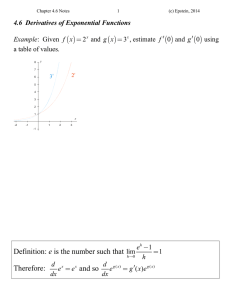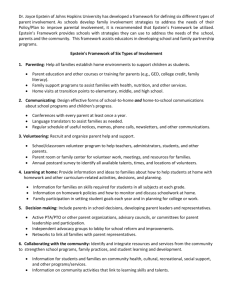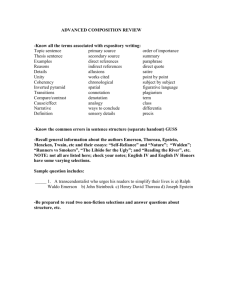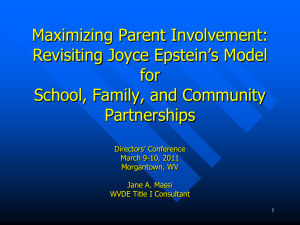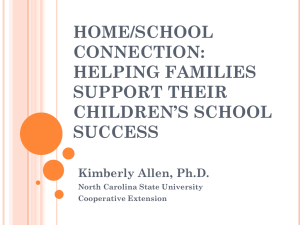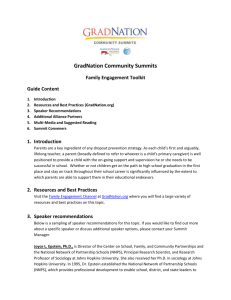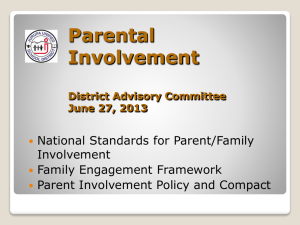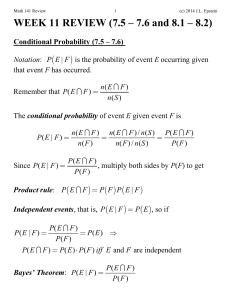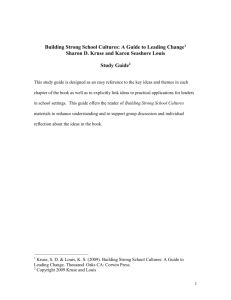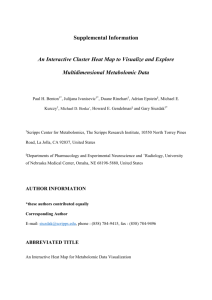File
advertisement
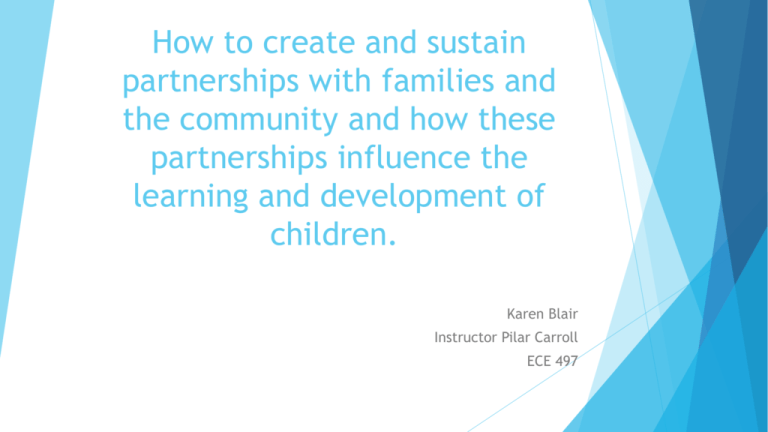
How to create and sustain partnerships with families and the community and how these partnerships influence the learning and development of children. Karen Blair Instructor Pilar Carroll ECE 497 Pre-K through 6th grade There’s a lot of development going on at these ages (4-12 years). -Children usually master the semantics and grammar by age 12 -Children grow a foot or more, and gain around 30 plus pounds -They learn the concept of water displacement - They understand the dynamics of friendships and start liking others in a sexual way Marotz and Allen, 2013) My role as a child development professional As a teacher, I am able to individualize each child and teach them however they learn. I am someone they can look up to and confide in. I am there to help them if a problem arises, and guide them to find the answer. I am there to support them, and build their confidence. How to create and sustain partnerships with families and the community and how these partnerships influence the learning and development of children Children may not always want their parents around, especially at school or community functions. However, when a child has a parent volunteer at either of these places, it benefits them in the long run. A recent study found that when parents participate in the school and community programs, the children’s attendance was better and they had less behavior problems (Griffin, 2010). Some ways to be included in your child’s school and community are: -Attend open house -Volunteer at sporting events (concession stand) -Volunteer in the community (after school -Be apart of the PTA activities, summer camps, church) -Homeless Shelters -Big Brother, Big sister program -Soup kitchen Bronfenbrenner’s Ecological Theory Mesosystem (Bronfenbrenner’s Ecological Theory) The Mesosystem is where a person’s microsystem, exosystem and macrosystem all combine and effect the individual. Everything in these systems can effect the way a child thinks, grows and develops. For example, If a child is being bullied at school, he/she is more likely to not participate in sports, do well academically and have poor self-esteem (Rigby, 2013). Another example of this is parental involvement. Some parents are able to transport their children to after school programs or music lessons. These parents are more overall involved in their child’s life with brings more positive support and have better relationships with their children (Berk 27). “In adolescence, too, religious youth groups, special interest clubs, and other neighborhood organizations contribute to favorable development, including self-confidence, school achievement, educational aspirations, and responsible social behavior” (Berk 27-8). Bronfenbrenner and Epstein These two theories have a lot in common in regards to how the involvement of one thing can influence another. In a nutshell, the commonalities show that the more involved the parents are in the positive development of the child, the better and more successful they will be. Epstein’s Types of Involvement Parenting -Help all families establish home environments to support children as students. Communicating -Design effective forms of school-to-home and home-to-school communications about school programs and children's progress. Volunteering -Recruit and organize parent help and support. Learning at home -Provide information and ideas to families about how to help students at home with homework other curriculum-related activities, decisions, and planning. Decision making -Include parents in school decisions, developing parent leaders and representatives Collaborating with the community -Identify and integrate resources and services from the community to strengthen school programs, family practices, and student learning and development. (Epstein, n.d.) and Parenting The first and most important involvement in a child’s life. According to Epstein, parenting and parenting styles are one of the many aspects in a child’s development (Epstein, n.d.). Having a parent involved in the school functions and communities has shown to have positive results in school grades, attendance and social skills. One way to include a parent is through fundraisers, open houses, bake sales and many parent volunteer days (show and tell, career day, field trips) (Epstein, n.d.). If there is a child that speaks another language, create a special day where you would teach a few words of that language and have the child explain some traditions. Involve the parent by having them work on a worksheet together for that day. Communicating Communication with the parent and child is something that is necessary for development. A child can learn if they can understand and are listening to you. A parent is the same way. Some ways to keep open communication with the parent is through parent/teacher conferences, providing language translators if needed, weekly emails, report cards, and newsletters. For the children, listening to them goes a long way. Sometimes, that’s all they need (Epstein nd). Volunteering For the children, having their parents and other parents around helps them with their social skills and may help them be more aware of other peoples family dynamics and skills they wouldn’t normally see (Epstein nd). For the parents, volunteering can help parents understand daily activities of both the child and the teacher, helps them feel more comfortable with the other children and teachers and can give them a sense of safety regarding their child and school (Epstein nd). A few ways to incorporate this is through creating opportunities where the parents are needed (field trips, bake sale, birthday parties) (Epstein nd). Learning at home Incorporating families to help the children with homework and schoolwork is something that will help create a bond between the family. Having a healthy relationship is one way to positively impact development of the child. A great idea that would increase that positive bond would be a literacy bag. In this book-bag is up to 5 books, flashcards, cite words and an instruction sheet for the parents. This is something that will build cognitive development as well as give that child some positive self-esteem. This idea is of no cost to the parents. One way to include a second language is to have a book or two in that language as well as separate flashcards in that language. Decision making Including parents in decisions for the school can make them feel empowered and important. Being on the PTA board as well as taking surveys on parents input can help parents feel more involved in their child’s life. This can bring families together and voice their opinion on important matters regarding their children. This type of involvement can also bring other parents together that may not have had the opportunity to before (Epstein, nd). Collaborating with the community Bringing the community into learning can be a fun and rewarding experience. Whether it be from summer camps, after school programs, community centers or clubs/sports teams, it can create a positive learning experience for all involved. Many of these programs are for a small fee or free, which makes it easier for low income families to take advantage of the opportunity to help their child flourish and gain new skills. One way to get the information out to parents is through the teacher. If the teacher can put together a packet or newsletter listing activities for the children to give to their parents, there may be a bigger turn out. Thank you for your time! THE END References Epstein, J. (n.d.). Epstein's framework of six types of involvement. Retrieved from http://www.unicef.org/lac/Joyce_L._Epstein_s_Framework_of_Six_Types_of_Inv olvement(2).pdf Griffin, D and Steen, S. (April 1, 2010). School-Family-Community Partnerships: Applying Epstein's Theory of the Six Types of Involvement to School Counselor Practice. Professional School Counselling. Vol. 13, Issue 4. Marotz, L.R. and Allen, K.E. (2013). Developmental Profiles: Pre-Birth Through Adolescence. Wadsworth, Centage Learning. Rigby, K. (2013). Bullying in schools and its relation to parenting and family life. Family matters. No.92.
